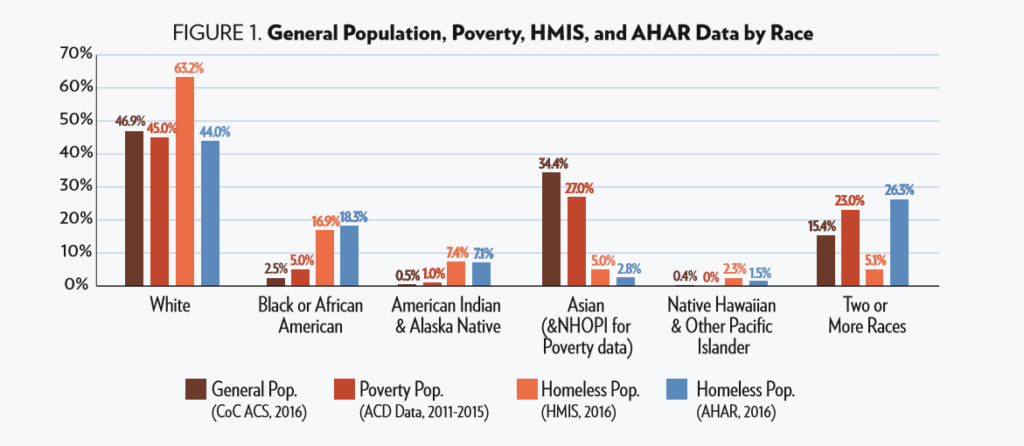Nearly 61 percent of Santa Clara County’s homeless population is Latino or black, a new report found, a figure that’s dramatically higher than the general population of those minorities in our county.
The report, prepared by Destination: Home in partnership with Supporting Partnerships for Anti-Racist Communities Initiative, detailed racial trends in the county’s homeless population. And it showed that minorities are overrepresented in the homeless community in the heart of Silicon Valley, and in similar areas of the country.
Although 27% of Santa Clara County is Latino, the report found they make up nearly 44% of the homeless population. Similarly, only 2.5% of the county’s population is black, but they account for nearly 17% of homeless people. American Indian and Alaskan natives are also overrepresented with less than 1% of the population but nearly 7.5% of the homeless population.
The report points to “a lack of affordable housing” for minorities as well as “structural inequities,” such as a racial wage gap and lack of economic opportunities, as reasons for the disparity. These trends among minorities in the homeless population are similar to those of people in foster care, tenants who have been evicted or individuals who have criminal records.

Camille Llanes-Fontanilla, executive director of SOMOS Mayfair, who sat on the advisory board for the report, said remnants of historic, institutional biases such as redlining still linger. These policies have had a ripple effect throughout minority communities.
“The root of a lot of poverty has been racial injustice,” she said. “The inability to generate wealth has been placed on the backs of black and brown people … these structures were built upon that bias. It is not about individual biases.”
The report, she said, allows advocates to “reconcile history” and attempt to undo policies that laid the groundwork to marginalize minorities. “There needs to be galvanized local will to move these systems,” Llanes-Fontanilla said. “In our community, we tend to shy away from these conversations.”
Jennifer Loving, CEO of Destination: Home, called the disproportionate amount of homeless minorities “disheartening.”
“Homelessness does not affect all people the same way. There are societal vulnerabilities that create a sense of urgency,” she said. “It really comes down to a few things: you have to have resources to address problems, the crisis … and you have to have the political will to solve these problems or they don’t get solved.”
Loving said she hopes the report will be a “rallying vehicle” by illuminating the disparity and helping advocates understand the homeless problem.
“Once we understand, we can know what to do,” Loving said. “We see this as a jumping off point. I think this is the beginning of addressing these problems.”
Rather than being a byproduct of poverty, the report contends that homelessness is more an issue of race.
According to the report, “… this is not simply an issue of poverty: people of color experience homelessness at rates significantly higher than the proportion of those living in poverty. Indeed, the legacy of historical and contemporary structural racism is at the root of who becomes homeless.”
Gina Dalma, senior vice president of public policy at the Silicon Valley Community Foundation, said having facts surrounding racial disparities can help better craft programs aimed to help minorities not fall into homelessness.
“It is multifaceted, (the) reasons why this is more race-related than income-related,” she said. “Now that we know it is race-related, we can use all these teaching moments … (to) make sure the program design, every segment of the pathway, is able to be accountable so that this bias doesn’t infiltrate things.”
To solve the issue, the report suggests including more homeless minorities in discussions about funding, policy and programs aimed to address homelessness. It also suggests aligning efforts to alleviate homelessness with committees already in place, such as those in the criminal justice system and health and human services.
“Usually people who make policies around homelessness have never been homeless,” Dalma said. “We need to make sure that we are providing solutions that are defined by the folks with the need.”
The report will also inform work on a new homelessness task force spearheaded by Santa Clara County Supervisor Dave Cortese.
“I don’t think this is a new issue as far as the identifying of the issue. It has festered and they (Destination: Home) are right to call it out,” Cortese said. “One of the biggest disappointments in my political tenure is the inability to organize a sustainable effort to attack this problem.”
Contact David Alexander at [email protected]
Editor’s Note: Jennifer Loving serves on San José Spotlight’s Board of Directors.
RacialEquityReport0131020



Leave a Reply
You must be logged in to post a comment.